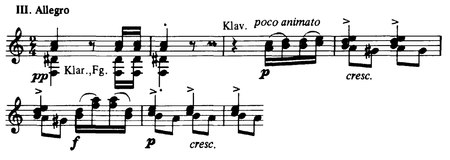History and influences
The work is among Grieg's earliest important works, written by the 24-year-old composer in 1868 in Søllerød, Denmark, during one of his visits there to benefit from the climate.
The concerto is often compared to the Piano Concerto of Robert Schumann: it is in the same key; the opening descending flourish on the piano is similar; the overall style is considered to be closer to Schumann than any other single composer. Incidentally, both composers wrote only one concerto for piano. Grieg had heard Schumann's concerto played by Clara Schumann in Leipzig in 1858, and was greatly influenced by Schumann's style generally, having been taught the piano by Schumann's friend Ernst Ferdinand Wenzel.
Grieg's concerto provides evidence of his interest in Norwegian folk music; the opening flourish is based on the motif of a falling minor second followed by a falling major third, which is typical of the folk music of Grieg's native country. This specific motif occurs in other works by Grieg, including the String Quartet No. 1. In the last movement of the concerto, similarities to the halling [5] (a Norwegian folk dance) and imitations of the Hardanger fiddle (the Norwegian folk fiddle) have been detected.
The work was premiered by Edmund Neupert on 3 April 1869, in Copenhagen, with Holger Simon Paulli conducting. Some sources say that Grieg himself, an excellent pianist, was the intended soloist, but he was unable to attend the premiere owing to commitments with an orchestra in Christiania (now Oslo). Among those who did attend the premiere were the Danish composer Niels Gade and the Russian pianist Anton Rubinstein, who provided his piano for the occasion. [6] Neupert was also the dedicatee of the second edition of the concerto (Rikard Nordraak was the original dedicatee), and James Huneker said that he composed the first movement cadenza. [7]
The Norwegian premiere in Christiania followed on August 7, 1869, and the piece was later heard in Germany in 1872 and England in 1874. At Grieg's visit to Franz Liszt in Rome in 1870, Liszt played the notes a prima vista (by sight) before an audience of musicians and gave very good comments on Grieg's work which would later influence him. The work was first published in Leipzig in 1872, but only after Johan Svendsen intervened on Grieg's behalf. [8]
The concerto is the first piano concerto ever recorded—by pianist Wilhelm Backhaus in 1909. [9] Due to the technology of the time, it was heavily abridged and ran only six minutes. [9]
Grieg revised the work at least seven times, usually in subtle ways, but the revisions amounted to over 300 differences from the original orchestration. In one of these revisions, he undid Liszt's suggestion to give the second theme of the first movement (as well as the first theme of the second) to the trumpet rather than to the cello. The final version of the concerto was completed only a few weeks before Grieg's death, and it is this version that has achieved worldwide popularity. The original 1868 version has been recorded, by Love Derwinger, with the Norrköping Symphony Orchestra under Junichi Hirokami. [10]
Grieg worked on a transcription of the concerto for two solo pianos, which was completed by Károly Thern. [11] The premiere recording of this version was by the British piano duo Anthony Goldstone and Caroline Clemmow. [12]
On April 2, 1951, the Russian-born American pianist Simon Barere collapsed while playing the first few bars of the concerto, in a performance with conductor Eugene Ormandy and the Philadelphia Orchestra at Carnegie Hall in New York. He died backstage shortly afterwards. [13] It was to have been Barere's first performance of the work. [14]
Second concerto
In 1882 and 1883, Grieg worked on a second piano concerto in B minor, but it was never completed. The sketches for the concerto have been recorded by the pianist Einar Steen-Nøkleberg. In 1997, the Oslo Grieg Society held its Third International Competition for Composers on the theme: of "re-imagine" Grieg's second concerto. One of the contestants, the Belgian composer Laurent Beeckmans, elaborated a full piano concerto from the sketches, which was first performed in London on 3 May 2003. [15]
Another elaboration on Grieg's sketches was completed by the Norwegian composer Helge Evju and was recorded by the Naxos label. [16] Among the other contestants the Romanian Șerban Nichifor (Concerto GRIEGoriano), the Russian Vladimir Belyayev (Second Piano Concerto), the Scottish Callum Kenmuir (Rhapsody on themes by Grieg), the American Daniel Powers (Concerto Reliquary), the German Klaus Miehling (Concert Fantasy in B minor), the New Zealander Alison Edgar (Fantasia in B minor), the Australian David Morgan (Norwegian Fantasy). The 1st prize went to the Italian Alberto Colla (Piano Concerto No. 1).
This page is based on this
Wikipedia article Text is available under the
CC BY-SA 4.0 license; additional terms may apply.
Images, videos and audio are available under their respective licenses.




